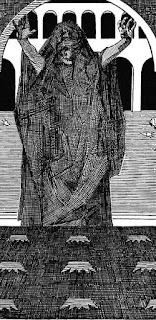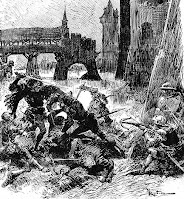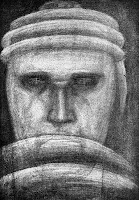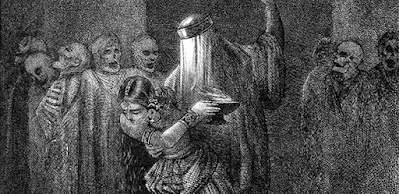 |
Scale: 10 ft.
Click here for a PDF version of this adventure! |
A - Hall Victorious
A1 - Main Hall
A downward-sloping natural cavern opens into a large, hewn room. 15 feet from the east and west walls, at 10 foot increments inside the room, are black metal sconces: empty. At the northern half of the room is a moai - 8 feet wide by 12 feet tall. The eyes, nose, and mouth appear to have been fitted with something, but the pieces are missing.
The pieces are hidden through the dungeon; or - depending on your milieu, perhaps they have been looted and are hidden nearby. If all pieces are inserted correctly, a platform on which the moai sits will sink into the floor, dropping eight feet, revealing access to A2. To close the ingress to A2, one or more of the moai features can be removed. The opening and shutting process of the lift takes 3 rounds.
However, the moai is trapped twice over:
|
The correct order of the eyes is blue on the right; red on the left. If the right eye and left eye are inserted incorrectly, the right into the left socket and vice versa, a light will emerge from them: red from the left eye and blue from the right eye: approximately in 45 degree arcs from each. Characters caught in the blue light only must Save vs Petrification or turn to salt; characters caught in the red light must Save vs Spells or be aged to venerability: reducing all ability scores by half. Characters caught in the middle - both at once - must Save vs Death or be disintegrated.
|
If the false nose is placed into the nose socket, the chin of the moai will fall, causing the mouth to fall out, if inserted, and releasing a toxic gas that hangs low to the ground. Any character within 15 feet of the statue must Save vs Poison; any character within 30 that is not able to retreat from it likewise must Save vs Poison on the following round, but benefits from a +2 bonus to the save. Any character at or outside 45 feet is not close enough to be affected. After three rounds, the poison sinks into the floor. Dwarves and Halflings save at a -2 penalty due to their stature.
|
The east door is stuck, but not locked. The west door is neither.
A2 - Horde Gate
Three doors to three rooms beyond this room are wrought iron, inlaid into a wall of bars: a character would not be able to slip through, but can see through into the darkness. The north door is not locked; the east and west doors are chained shut with large, ostentatious seals: the seals can be broken without much effort.
A3 - Sword of the Forgotten King
In this room is a pedestal holding a sword; around it, lining the walls, are several chests. If the sword is handled, the chests begin to lose their corporeality - unable to be grasped; if the chests are emptied, the sword begins to slide into the pedestal - unable to be freed. Inside the chests are 800 silver pieces, 600 gold pieces, and three fire-opals worth 50 gold pieces each. On the west wall is a relief carving depicting the sun.
The sword is a +1 longsword, +3 versus undead. Adjacent to it are three gems: a small moon sapphire, 100 gp, and two large garnets (500 gp each).
A4 - Throne Sepulcher
A stone chair with a desiccated corpse - mummified by time and dry rather than intention - slouched against it; the corpse appearing to have fallen from its original posting. It wears a tunic and a visor - the visor is made of wood and silver, worth 450 gold pieces to a collector. It has a scabbard in its belt, its right hand is empty, and in its left hand, it clutches a key.
A5 - False Horde
In this room are several half-dissolved wooden chests and a Gray Ooze (B36). The chests contain some lead figurines, some mostly-rotted books, and dust. On the east wall is a relief carving depicting the moon, complete with facial features, that the man-in-the-moon appears sleeping. If the key held by the corpse in A4 is inserted into the nose of the man-in-the-moon, the door to A6 will open.
A6 - The King's Horde
The walls of this room are adorned with dyed curtains, aged - but heavy. They are adorned with gold fittings worth 800 gp. There are two chests on the north and south walls, each, and each contains 2,000 silver pieces. In the center of the east wall, there is a glass case containing two crowns, similar to the one worn by the mummy, but one is gold with citrines, the other silver with diamonds. Both are worth 1,200 gold pieces. In addition can be found an ivory scepter with platinum topper (700 gp), an electrum torc (600 gp), and a sash made of thin linked plates - silver, with gold trim - (900 gp).
The chests are sealed and must be forced open. The glass case is locked and trapped with a poison needle - though the needle does not activate if the glass is simply broken.
B - Western Passages
B1 - The West Way
The west door leads to what appears to be a closet; though the floor is damp - a hint to the presence of a secret door - upon entry. Just to the south, a group of 4 Neanderthals (B39) are audibly fighting with a group of 6 Giant Rats (B41).
B2 - Guards' Tomb
In the center of the room is a dining table - chairs missing. Ringing the table on each face except south are stone coffins, three to the north and two each to the east and west, respectively. On the dining table is a silverware set worth 100 gold pieces.
Inside each sarcophagus is a Skeleton (B42) in repose. If any sarcophagus is opened, all skeletons will attempt to open their sarcophagi and attack. The lids, however, are heavy: and each skeleton only has a 2-in-6 chance of opening the lid each round. A referee is encouraged to modify this chance if the players are clever (or foolish) in their response: that is, placing additional weight on the lids may buy them time or prevent the inhabitant of the weighted coffin from escaping entirely.
B3 - Nose Creek
Doors exiting this room are obvious from the inside, and easy to open. A crack in the ceiling drips sparkling water into a groove in the floor running south-west to north-east. There is an abundance of lichen growing along where this water seems to slowly drain eastward. In the south-west corner, there is a deeper pool, formed by some debris: in this pool is the nose of the moai.
The nose of the moai is obsidian, with black pearls for nostrils. On its own, it would be worth 1,500 gold pieces: but it would be difficult to find a buyer.
The lichen has curative properties, if applied to a wound or injury causing a Save vs Poison, will allow the user to re-roll a failed save. If eaten, it restores 1 hit point. There is enough lichen, if harvested, for 2d3 doses. The water tastes good, but has no other affects.
B4 - The Narrow WayThe door to B5 is made of wood and is locked. A skeleton sits, propped against the north east corner of the alcove into which the door is set. Four Cave Locust (B32) are milling about in the narrows of the hallway. The secret door to the north is a concealed sliding door, opening towards the west, with a sliding clasp hidden just above a man's average height in a nook in the stone to unlock it.
|
B5 - A False NoseOn the northern and southern extents of this room are several large vases, each filled with flowers. The flowers have long since desiccated. In the center of the room is a pedestal with what appears to be a large nose - made of basalt - with a ridge on the rear side, as though a hanger. Scattered around the floor in a circle around the pedestal is 1,000 silver pieces. This nose is a false nose. If inserted, it will activate the moai's mouth trap. On its own, it has little or no value if sold. |
C - The Eastern Corridor
C1 - Tribute to the Moai
In a nook on the northern wall is a smaller moai wearing an expression of disgust. It is facing slightly off, slightly south-west instead of south as might have been implied, as though jarred by a passing body. To the east of the moai statue is growing a set of fungi stalks, red in color and between three and four feet tall - they are harmless.
Behind the moai is a secret door, through the grooves of which, a moderately repugnant smell is emanating. This smell is only detectable if a character is close enough to the moai to interact with it, and thus would be noticed if a character explicitly investigates the statue. The door, itself, is concealed by a simple inlay into the pattern of the hewn walls and will slide inward if even pressure is applied to three of its four corners.
C2 - Ogre's Cave
An Ogre occupies this space, wearing the mouth of the statue in his own mouth, as a set of wax lips: chuckling and thinking himself dreadfully clever for so doing. In addition, he has auspiciously hanging from the walls a diamond necklace (1200 gp), a gold chain inlaid with alternating aquamarine and zircon (900 gp), a sapphire bracelet (1,100 gp; slightly damaged: he might have tried it on), a set of topaz earrings (1,100 gp for the set), and 2,000 gold pieces.
The mouth, itself, has a peg or ridge in the back that will allow it to fit into the mouth of the moai in A1. Its lips are obsidian; its teeth are nacre. It would be difficult to sell, but is worth 2,000 gold pieces.
C3 - The Iron Ballroom
Along the north and south walls of this room are nooks wherein candelabra may be placed. Hanging from the ceiling - roughly in the middle, east to west, and 10 feet north from the southern wall, is a chandelier made from glinting steel. In each of the two nooks in the northern wall, where the hallway from C1 terminates, is a Living Statue, Iron (B37), which will attack on sight. Any character entering from the north is likely to be surprised; any character entering from the west door is unlikely to be surprised.
The door in the west wall is heavy (counts as stuck), as though made for strong arms, but is not locked.
Inside the chandelier - but hidden from view from below - is the left eye of the moai in A1: which is ringed with obsidian, a nacre white, and a ruby pupil. Alone, it is worth 1,000 gold pieces, but would be difficult to sell.
C4 - Bloody Store
In the south west corner of the room are a set of barrels - empty, dry. In the north west corner, empty crates. In the center of the room is a freshly dead adventurer clutching an open satchel while lying in a pool of drying blood. The adventurer is wearing leather and carrying some random equipment (rope, rations, torches, etc. - the referee is encouraged to ad lib) - notably absent, however, is any metal equipment at all on his person.
The north door is locked. The south door is heavy (counts as stuck), but not locked.
C5 - A Room to Cavern, Reclaiming
The ceiling of this room drips and is overgrown with hanging plants. The walls are hewn, but the floor is in decay - broken, with rubble and rocks from where the ceiling has collapsed. There is an earthy scent to the room and a 20% chance the party will be attacked by 2-8 centipedes dropping from the ceiling: as Centipede, Giant (B33) excepting that their attack - on hit - requires a Save vs Poison: on failure, 1 point of Wisdom is temporarily drained. Drained Wisdom lost in this manner will heal at a rate of 1 point per day.
The east door is stuck.
The secret door is a pocket door, sliding into the wall when a character activates an unlocking mechanism in a nook that is covered in moss.
D - The Southern Chambers
D1 - The Old Refectory
This space is barren - though the floor has a discolored look to it, as though there once was a table in the center, rotted away from age or perhaps stolen. In the ceiling is a horde of normal bats (B30) which, if a party gets too close, will panic and take flight.
The door to B4 is stuck, but not locked.
The door to D2 is not locked.
There is a pit trap 20 feet deep in the hallway leading east.
D2 - House of the Blue Eye
The north door is not locked. In each corner of the room are large brass sconces, empty. Along the floor, however, is emblazoned a large Celtic knot in a green mosaic pattern. At each cardinal point - north, south, east, and west, an emerald is inlaid in the floor (400 gp each, if pried out) - and in the center, the right eye of the moai.
The eye is facing upward, emitting a dim blue glow as though a light were shining beneath it. It is ringed by obsidian, the white is nacre, and the pupil and iris are a large sapphire. If the eye is removed from its hole, a portcullis drops at the door, trapping whomever is inside the room. If the eye is replaced, the portcullis will lift.
On its own, the eye would be worth 1,000 gold pieces, but may pose a challenge to sell.
D3 - The Coin Pool
A circle of raised brick forms a concave center to this room. The circle is partly full of stagnant, but clear water. In the water, almost as a wishing fountain, are 500 silver pieces.
On the west wall is an amulet portraying the moon - made of electrum with opal inlays - worth 1,100 gold pieces; on the east wall is a headdress, gold, that appears to portray the sun, along with emerald inlay. The headdress is worth 1,200 gold pieces.
Public domain artwork retrieved from OldBookIllustrations.com, ReusableArt.com, and the National Gallery of Art and adapted for thematic use. Attribution in alt text.




























